Frank Lloyd Wright the principle of “Organic Architecture” with his 1900 “Prairie Houses,” and the Robie House Chair. His works are practical examples of unity between the natural environment, exterior, and interior design.

Image source: https://commons.wikimedia.org/wiki/File:Frank_Lloyd_Wright_Chair_04.jpg
A Piece of a House
Frank Lloyd Wright designed this high-back chair for the dining room of the Frederick C. Robie House, which is an Hyde Park (Chicago) single-family house. The high-back shape of the chairs, arranged around the table, separated the dining area from the rest of the room and create a cozy, intimate feeling of an almost independent area. This was common with furniture used in Prairie house interiors. Notably, there are strikingly high backs, and gently curved legs, softening the rigor of the geometric design in a more organic shape.
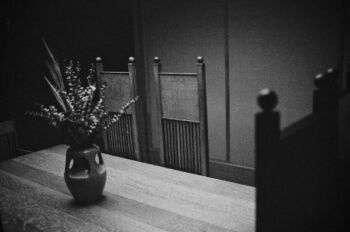
Image source: https://search.creativecommons.org/photos/fc7471a5-22ec-46de-9863-44ff418cc0f0 by Crawford Brian
The chair was designed for Frederick C. Robie’s house, which is located on the University of Chicago campus in the southern Hyde Park neighborhood of Chicago, Illinois. The edifice was built between 1909 and 1910 and is widely known as the greatest example of the Prairie School style in distinctly American taste. Additionally, Robie House was nominated as the National Historic Site of the United States.

Image source: https://search.creativecommons.org/photos/da080673-ce6b-4c57-a3e8-ccf4697f9be9 by Teemu008
The so-called “Prairie Style,” or Wright’s revolutionary brand of architecture, was coined by critics and historians who noted that the buildings and their various components owe their design to the landscape and plant life of the Midwestern prairie. Like most of Wright’s Prairie houses, he designed all the interiors, windows, lighting, carpets, furniture, and fabrics. As Wright himself wrote in 1910, “It is impossible to regard a building as one and its furnishings as another… These are all just structural details of its character and completeness.”

Image source: https://search.creativecommons.org/photos/651c5b89-41ab-41af-91e1-d4422ed9418f by westher
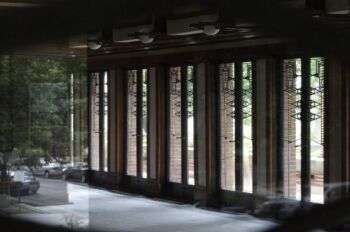
Image source: https://search.creativecommons.org/photos/576d8fae-6ef9-4794-a484-42c8a30dec41 by westher
Wright’s Style
Frank Lloyd Wright’s ideology focused on the complete integration of the house-site and structure, interior and exterior, furniture, ornament, and architecture. He made sure every project element was conceptually connected. Further, he designed oak furnishings with straight lines and rectilinear shapes in the tradition of the Arts and Crafts, which aimed for strength and simplicity.
In the early 1890s, as Wright was working to define his vision for new American architecture, he designed furniture for his Oak Park house. Between 1890 and 1895, English artist and designer William Morris created built-in window seats and two sturdy oak armchairs for the living room.
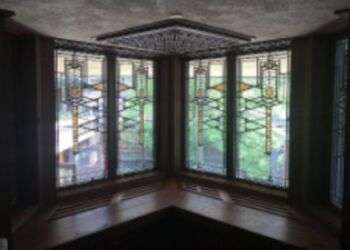
Image source: https://search.creativecommons.org/photos/669ce0f8-6280-4a59-9900-df20932d8df9 by Jules Antonio
For the dining room, Wright further integrated furniture and lighting, enriching the former with innovative uses of the latter. Additionally, Wright embraced electricity from the start of his career, complementing natural lights with incandescent ones. The dining table and eight high back chairs, created for the dining room of the home, were revolutionary for the time. This is due to their overriding verticality and simplicity, marking a clear step towards a new aesthetic in Wright’s designs. The furniture forms an intimate secondary space in the room, and the table shielded by the high backs of the dining chairs. Further, the atmosphere has a wall sconces of leaded glass, oak, and bronze incorporated materials and motifs that blend space and materials
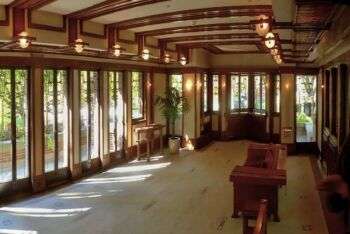
Image source: https://search.creativecommons.org/photos/cbe3eb50-687f-4795-b8a1-22bdd4c1ebfa by ivtoran
Robie 1 Cassina
Designed by Frank Lloyd Wright in 1908, this chair was re-edited by Cassina in 1986 and included in the “Cassina I Maestri” Collection. 601 Robie 1 chair for Cassina is either natural cherrywood, stained cherrywood, or natural canaletto walnut. Seat upholstery is often polyurethane foam and covered with fabric or leather.
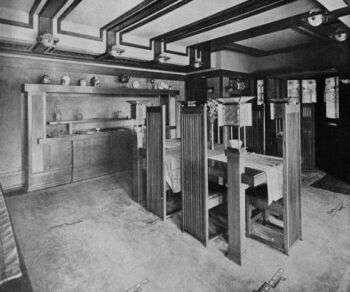
Image source: https://en.wikipedia.org/wiki/Robie_House#/media/File:Robie_House_Interior_HABS_ILL,16-CHIG,33-7.jpg
Data Sheet
- Designer: Frank Lloyd Wright
- Year: 1908 (re-edited in 1986)
- Manufacturer: Cassina
- Dimension: w. 40 x d. 45,5 x h 133,5 |hs 46 cm
- Materials: Chairs in natural cherrywood, cherrywood stained walnut, or American walnut finish. Seat upholstery in polyurethane foam, with fabric or leather upholstery.
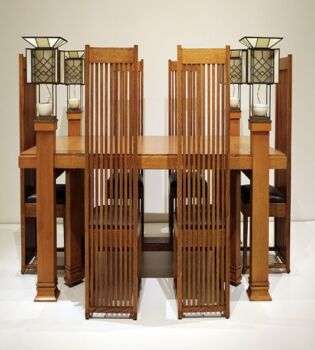
Image source: https://commons.wikimedia.org/wiki/File:Frank_lloyd_wright,_tavolo_da_pranzo_e_sei_sedie,_da_robie_house,_1907-10_ca._01.jpg
Info sources:
